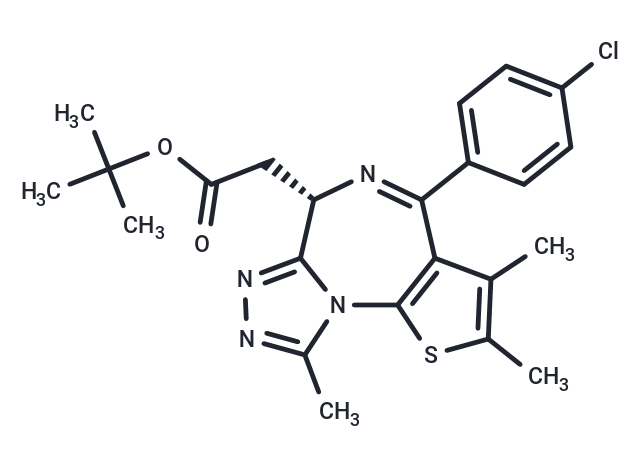Shopping Cart
- Remove All
 Your shopping cart is currently empty
Your shopping cart is currently empty

(+)-JQ-1 (JQ1) is a specific, reversible BET bromine domain inhibitor that targets BRD4 (1/2) with IC50 values of 77/33 nM. (+)-JQ-1 induces cell autophagy and inhibits cell proliferation.

| Pack Size | Price | Availability | Quantity |
|---|---|---|---|
| 1 mg | $30 | In Stock | |
| 2 mg | $37 | In Stock | |
| 5 mg | $55 | In Stock | |
| 10 mg | $72 | In Stock | |
| 25 mg | $97 | In Stock | |
| 50 mg | $147 | In Stock | |
| 100 mg | $198 | In Stock | |
| 200 mg | $297 | In Stock | |
| 500 mg | $539 | In Stock | |
| 1 mL x 10 mM (in DMSO) | $61 | In Stock |
| Description | (+)-JQ-1 (JQ1) is a specific, reversible BET bromine domain inhibitor that targets BRD4 (1/2) with IC50 values of 77/33 nM. (+)-JQ-1 induces cell autophagy and inhibits cell proliferation. |
| Targets&IC50 | BRD4(1):77 nM(cell free), BRD4(2):33 nM(cell free) |
| In vitro | METHODS: The BRD4-NUT-dependent cell line NMC 797 was treated with (+)-JQ-1 (250 nM) for 48 h. The cell cycle was detected using Flow Cytometry. RESULTS: (+)-JQ-1 induced G1 cell cycle arrest. [1] METHODS: Human multiple myeloma cells KMS11, LR5, OPM1 and INA-6 were treated with (+)-JQ-1 (500 nM) for 24 h, and the expression levels of target proteins were detected by Western Blot. RESULTS: (+)-JQ-1 inhibited c-Myc protein expression in expanded Myc-dependent MM cell lines. [2] |
| In vivo | METHODS: To detect anti-tumor activity in vivo, (+)-JQ-1 (50 mg/kg, 5% DMSO in 5% dextrose) was administered intraperitoneally to NCr nude mice bearing NMC xenograft tumors once daily for eighteen days. RESULTS: Significant tumor regression and improved overall survival were observed after (+)-JQ-1 treatment. [1] METHODS: To detect anti-tumor activity in vivo, (+)-JQ-1 (50 mg/kg) was intraperitoneally injected into nude mice carrying human gastric cancer tumor HGC27 once daily for two weeks. RESULTS: (+)-JQ-1 prevented the growth of gastric cancer tumors and inhibited tumor metastasis. [3] |
| Cell Research | Cells were plated at 5,000 cells per well of 96-well plates containing titrations of the compounds as indicated. After incubation, the cells were washed once with PBS and resuspended in 175 μL of ice-cold 70% ethanol and fixed for a minimum of 16 h at 4 °C. The cells were pelleted and washed 1× with PBS and stained for 30 min at room temperature (RT) with 120 μL of staining solution [propidium iodide (20 μg/mL), RNase A (25 μg/mL), 0.1% Triton X-100 in PBS]. Cell number and cell cycle data were obtained by using a flow cytometer using the Express Pro module. DNA content histograms were analyzed by using ModFit LT 3.2 Software. To calculate the number of viable cells in each well, the concentration of events measured using the Guava was multiplied by the volume of cells in the well, then by the fraction of cells in G1+S+G2/M. GI50 values for each cell line were calculated as the concentration of compound giving a 50% reduction in cell number relative to the DMSO control [4]. |
| Animal Research | (Harlan) inoculated s.c. with 3 × 10^6 cells per mouse resuspended in 10% Matrigel. Two weeks later (average tumor volume 150 mm3), mice were assigned into two groups: 15 mice were treated with vehicle control (5:95 DMSO:10% 2-Hydroxypropyl-β-cyclodextrin), and 15 mice were treated with 30 mg/kg (+)-JQ1 by i.p. injection twice a day for 28 d. Body weight and tumor volume were measured daily. Tumor volume was calculated from caliper measurements by using the following formula: W × H × L × 0.52. Mice were killed when tumor volume reached 2,000 mm3, when body weight decreased >20% of initial weight, or when the mice were in poor health as established in the IACUC protocol. Survival was plotted and analyzed in GraphPad Prism software, and statistical significance was calculated by using log-rank (Mantel-Cox) and Gehan–Breslow–Wilcoxon tests. MV4-11 xenografts were established in nude mice injected with 10 × 10^6 cells per mouse. JQ1 was dosed i.p. and formulated as described above. Mice were divided into 4 groups of 10 animals: vehicle control once a day; 50 mg/kg (+)-JQ1 once a day; 30 mg/kg (+)-JQ1 twice a day; and cytarabine 100 mg/kg daily (5 d on, 2 d off). Treatment of mice with cytarabine at 100 mg/kg resulted in significant weight loss at day 8 and, therefore, the dose needed to be decreased to 75 mg/kg [4]. |
| Alias | JQ1 |
| Molecular Weight | 456.99 |
| Formula | C23H25ClN4O2S |
| Cas No. | 1268524-70-4 |
| Smiles | CC=1C2=C(N3C([C@H](CC(OC(C)(C)C)=O)N=C2C4=CC=C(Cl)C=C4)=NN=C3C)SC1C |
| Relative Density. | 1.33 g/cm3 |
| Storage | keep away from direct sunlight | Powder: -20°C for 3 years | In solvent: -80°C for 1 year | Shipping with blue ice. | ||||||||||||||||||||||||||||||
| Solubility Information | 10% DMSO+40% PEG300+5% Tween 80+45% Saline: 2.94 mg/mL (6.43 mM), In vivo: Please add the solvents sequentially, clarifying the solution as much as possible before adding the next one. Dissolve by heating and/or sonication if necessary. Working solution is recommended to be prepared and used immediately. Ethanol: 45.7 mg/mL (100 mM), Sonication is recommended. DMSO: 45 mg/mL (98.47 mM), Sonication is recommended. | ||||||||||||||||||||||||||||||
Solution Preparation Table | |||||||||||||||||||||||||||||||
DMSO/Ethanol
Ethanol
| |||||||||||||||||||||||||||||||

Copyright © 2015-2025 TargetMol Chemicals Inc. All Rights Reserved.